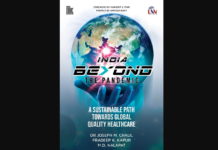The novel Corona virus is a very “stealthy” and “deadlier” version of the family of respiratory infection viruses. It is spread exponentially primarily because of two reasons. Firstly in the first 5-7 days of getting infected, there is no symptom, and the infected person can transmit the virus to other people and also in a period of 7-10 days until the person recovers. Second, we have no effective remedy or vaccine for it.
A few facts about how it spreads:
Since it infects the respiratory system (lungs, throat), an infected person can eject viruses into the air by coughing and sneezing. The carrier for these viruses is moisture particles or micro-bubbles in your breath, cough, or sneeze.
The distance traveled by these virus-laden moisture particles (sometimes called aerosols or airborne micro-bubbles) from an infected person’s mouth depends mainly on the mechanism of the ejection, i.e., breathing, cough, or sneezing. A loud cough or sneeze can throw these virus-laden micro-bubbles up to 5-6 feet and can hang around in the air for up to 4 hours.
 These ejected micro-bubbles carrying viruses will generally fall on surfaces that we use every day and can survive up to 4 days, depending on the chemical nature of the surfaces.
These ejected micro-bubbles carrying viruses will generally fall on surfaces that we use every day and can survive up to 4 days, depending on the chemical nature of the surfaces.
You can see that how by being close to people, or touching many commonly shared surfaces (knobs, cartons, counters, etc.) by people, and then touching your face, nose or mouth unknowingly, and even ingesting food that may have been sneezed upon, or touched by infected hands, can inoculate you with the virus.
How do we avoid getting infected? Given that we have no vaccine or cure yet to stop the progression of infection, the best solution is to observe social distancing and always “washing hands before touching your face.” It will be at least 1-1.5 years before vaccines can start to show up, and probably longer before these are available in volume to take care of people. Hydroxy-Chloroquine is not proven yet. It is going through trials to test its efficacy. Another method of injecting antibodies extracted from the recovered patients is approved by the FDA but can have scaling issues.
Scale testing measures have to come up in the next month or so. Initial prioritization must be for health workers and first responders, and for workers in essential services of the economy. All communities must take responsibility quickly to create facilities for such mass testing and isolate all infected individuals until they are virus-free.
To safely open economic activity in various affected industries, new preventive measures must be devised by businesses to ensure virus free employees, products, and services. They should prioritize testing for their employees, and do it frequently, to make sure that they are not acting as an infection spreading nodes.
The next year or so, it will be a difficult period, but we can make the misery much smaller by acting together and safeguarding our communities through diligently following good practices recommended by the CDC.
Reference Research Papers and Websites:
https://www.nejm.org/doi/full/10.1056/NEJMc2004973
https://www.medicalnewstoday.com/articles/320690
https://www.cdc.gov/
Ritesh is Congressional Candidate from District 17th, more details visit: www.tandonforcongress.com







